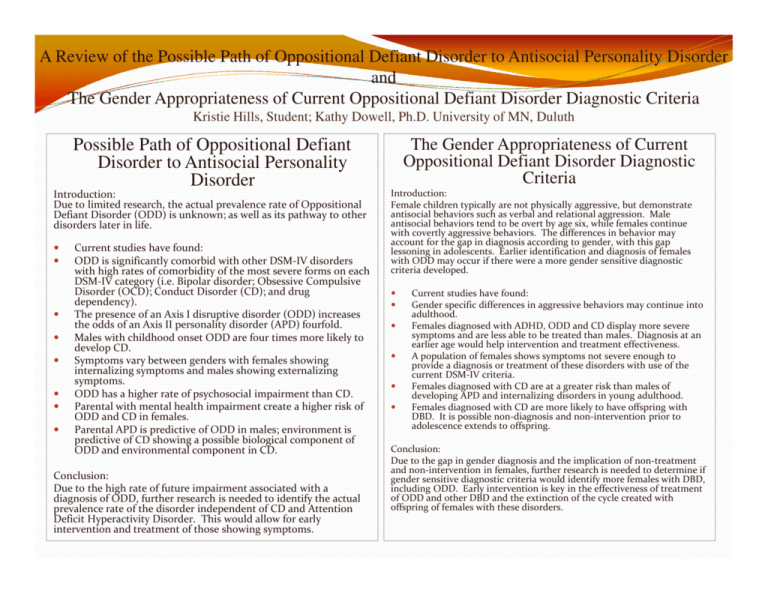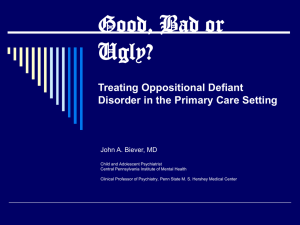Possible Path of Oppositional Defiant Disorder to Antisocial
advertisement

A Review of the Possible Path of Oppositional Defiant Disorder to Antisocial Personality Disorder and The Gender Appropriateness of Current Oppositional Defiant Disorder Diagnostic Criteria Kristie Hills, Student; Kathy Dowell, Ph.D. University of MN, Duluth Possible Path of Oppositional Defiant Disorder to Antisocial Personality Disorder Introduction: Due to limited research, the actual prevalence rate of Oppositional Defiant Disorder (ODD) is unknown; as well as its pathway to other disorders later in life. Current studies have found: ODD is significantly comorbid with other DSM-IV disorders with high rates of comorbidity of the most severe forms on each DSM-IV category (i.e. Bipolar disorder; Obsessive Compulsive Disorder (OCD); Conduct Disorder (CD); and drug dependency). The presence of an Axis I disruptive disorder (ODD) increases the odds of an Axis II personality disorder (APD) fourfold. Males with childhood onset ODD are four times more likely to develop CD. Symptoms vary between genders with females showing internalizing symptoms and males showing externalizing symptoms. ODD has a higher rate of psychosocial impairment than CD. Parental with mental health impairment create a higher risk of ODD and CD in females. Parental APD is predictive of ODD in males; environment is predictive of CD showing a possible biological component of ODD and environmental component in CD. Conclusion: Due to the high rate of future impairment associated with a diagnosis of ODD, further research is needed to identify the actual prevalence rate of the disorder independent of CD and Attention Deficit Hyperactivity Disorder. This would allow for early intervention and treatment of those showing symptoms. The Gender Appropriateness of Current Oppositional Defiant Disorder Diagnostic Criteria Introduction: Female children typically are not physically aggressive, but demonstrate antisocial behaviors such as verbal and relational aggression. Male antisocial behaviors tend to be overt by age six, while females continue with covertly aggressive behaviors. The differences in behavior may account for the gap in diagnosis according to gender, with this gap lessoning in adolescents. Earlier identification and diagnosis of females with ODD may occur if there were a more gender sensitive diagnostic criteria developed. Current studies have found: Gender specific differences in aggressive behaviors may continue into adulthood. Females diagnosed with ADHD, ODD and CD display more severe symptoms and are less able to be treated than males. Diagnosis at an earlier age would help intervention and treatment effectiveness. A population of females shows symptoms not severe enough to provide a diagnosis or treatment of these disorders with use of the current DSM-IV criteria. Females diagnosed with CD are at a greater risk than males of developing APD and internalizing disorders in young adulthood. Females diagnosed with CD are more likely to have offspring with DBD. It is possible non-diagnosis and non-intervention prior to adolescence extends to offspring. Conclusion: Due to the gap in gender diagnosis and the implication of non-treatment and non-intervention in females, further research is needed to determine if gender sensitive diagnostic criteria would identify more females with DBD, including ODD. Early intervention is key in the effectiveness of treatment of ODD and other DBD and the extinction of the cycle created with offspring of females with these disorders.






